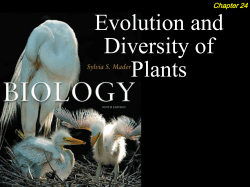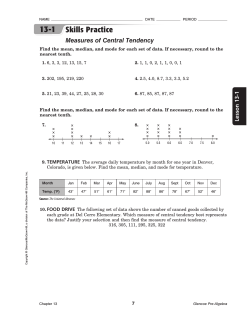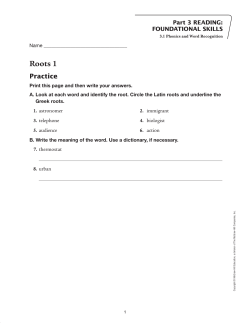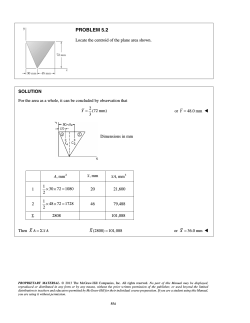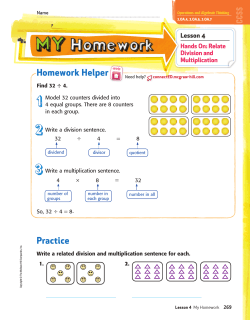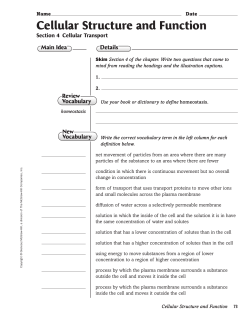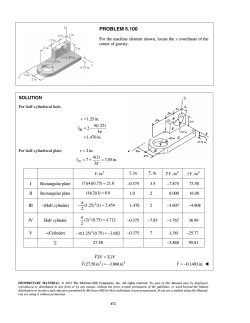
Lesson 2 | Seedless Plants
Lesson 2 | Seedless Plants Student Labs and Activities Page Appropriate For: Launch Lab 27 all students Content Vocabulary ELL 28 all students Lesson Outline ELL 29 all students Content Practice A 31 AL AL AL Content Practice B 32 AL OL BL School to Home 33 Key Concept Builders 34 Enrichment 38 Challenge 39 Skill Practice 40 all students AL AL AL all students AL AL BL all students Assessment Lesson Quiz A 42 AL AL AL Lesson Quiz B 43 AL OL BL Teacher Support Answers (with Lesson Outlines) AL Approaching Level T4 OL On Level BL Beyond Level ELL English-Language Learner Teacher evaluation will determine which activities to use or modify to meet any ELL student’s proficiency level. Copyright © Glencoe/McGraw-Hill, a division of The McGraw-Hill Companies, Inc. 26 Plant Diversity Name Date Launch Lab Class LESSON 2: 20 minutes Which holds more water? Peat moss is the common name of approximately 300 different types of mosses. The partially decomposed remains of these moss plants form peat moss. Some potting soils contain peat moss. Procedure 1. Read and complete a lab safety form. 2. Fill a 250-mL beaker with potting soil to about 3 cm from the top. 3. In a tub, mix equal parts peat moss and potting soil. Fill a second 250-mL beaker to the same level with this mixture. 4. Pour 30 mL of water into each beaker. Examine the beakers after 5 minutes and record your observations in the Data and Observations section below. 5. After another 5 minutes, place each beaker on its side in an aluminum pie pan. Record your observations. Copyright © Glencoe/McGraw-Hill, a division of The McGraw-Hill Companies, Inc. Data and Observations Think About This 1. How quickly did each soil mixture absorb the water? 2. What happened when you placed the beakers on their sides in the pie pans? 3. Key Concept Why do you think peat moss is added to potting soil? How might this benefit plants? Plant Diversity 27 Name Content Vocabulary Date Class LESSON 2 Seedless Plants Directions: Explain the relationship between the terms in each pair on the lines provided. Use complete sentences. 1. diffusion; osmosis 2. frond; leaf 28 Copyright © Glencoe/McGraw-Hill, a division of The McGraw-Hill Companies, Inc. 3. root; rhizoid Plant Diversity Name Date Class Lesson Outline LESSON 2 Seedless Plants A. Nonvascular Seedless Plants 1. Nonvascular seedless plants are often referred to as . a. Bryophytes are usually small, lack tissue, and live in environments. b. Materials move in bryophytes by diffusion or from cell to cell. c. Bryophytes do not have roots, stems, or . d. Bryophytes have rootlike structures called , which anchor it to a surface. e. Reproduction in bryophytes requires water and occurs by . f. Mosses, liverworts, and are bryophytes. 2. The most common bryophytes, live in shady, damp environments and can survive long periods of . Copyright © Glencoe/McGraw-Hill, a division of The McGraw-Hill Companies, Inc. a. Mosses have leaflike structures that grow on a stemlike structure called a(n) . b. Mosses have rhizoids. c. Mosses are often the plants to grow in barren areas or after a natural disturbance such as a fire or a mudslide. d. Mosses can retain large amounts of , which makes moss a useful additive for potting soil. 3. look like the flattened lobes of a liver. a. The of liverworts are unicellular. b. The two common forms of liverworts are and thallose liverworts. 4. are named for their long, hornlike reproductive structures. a. Hornworts reproduce by b. Each photosynthetic cell in a hornwort has only one Plant Diversity . . 29 Name Date Class Lesson Outline continued B. Vascular Seedless Plants 1. Vascular plants make up more than percent of plant species. 2. Unlike nonvascular plants, vascular plants contain vascular tissue in their , roots, and leaves. 3. plants contain tubelike structures that transport water and nutrients, which allows these plants to grow nonvascular plants. 4. than fuels come from the remains of ancient vascular seedless plants. 5. The , or leaves of ferns, make up most of a fern. a. Ferns grow in many , including dry, rocky cliffs and damp, swampy areas. b. People grow ferns in their homes and gardens and sometimes eat their young fronds, called . 6. Unlike mosses, have roots, stems, and leaves. a. Club mosses are small plants, whose stems grow along the . b. The fine powdery spores of club mosses are been used to make 7. and have . have small leaves that grow in circles around the stems. a. Horsetail stems are hollow and the tissue contains ,a mineral found in sand, that makes them abrasive. b. Horsetails were once used to scrub 30 . Plant Diversity Copyright © Glencoe/McGraw-Hill, a division of The McGraw-Hill Companies, Inc. and whose leaves are Name Date Class Content Practice A LESSON 2 Seedless Plants Directions: Label this diagram by writing the correct term from the word bank on the line. Some terms may not be used. bryophytes rhizoids spores vascular tissue 1. Copyright © Glencoe/McGraw-Hill, a division of The McGraw-Hill Companies, Inc. Directions: On each line, write the term from the word bank that correctly completes each sentence. Some terms may be used more than once or not at all. bryophytes ferns mosses nonvascular rhizoids spores vascular vascular tissue osmosis 2. A term used by scientists to describe nonvascular seedless plants such as the one shown in the drawing is . 3. Nonvascular seedless plants move materials from cell to cell by diffusion and . 4. Hornworts have hornlike reproductive structures that produce . 5. Over 90 percent of all plant species are 6. Vascular seedless plants, such as plants. , are usually larger than nonvascular seedless plants. 7. One difference between and club mosses is that club mosses have roots, stems, and leaves. Plant Diversity 31 Name Date Class Content Practice B LESSON 2 Seedless Plants Directions: Complete the diagram with the correct terms in the space provided. Some answers have been provided for you. club mosses ferns hornworts horsetails liverworts mosses nonvascular vascular Seedless Plants nonvascular horsetails 1. Describe two similar features of vascular and nonvascular seedless plants. 2. What is the major difference between vascular seedless plants and nonvascular seedless plants? 3. What are bryophytes? 4. Explain why nonvascular seedless plants usually are found in moist environments. 32 Plant Diversity Copyright © Glencoe/McGraw-Hill, a division of The McGraw-Hill Companies, Inc. Directions: Answer each question or respond to each statement on the lines provided. Name Date School to Home Class LESSON 2 Seedless Plants Did you know? Ferns once dominated Earth’s landscape. They grew to enormous sizes compared to the ferns that decorate our homes today. With the help of vascular tissue, ancient ferns often grew to the size of trees. For this activity, you will need two shallow bowls, a kitchen sponge, and a dropper. You will use the dropper to model transport of water through a vascular plant. You will use the sponge to model transport of water through a nonvascular plant. Fill both bowls with 2.5 to 5 centimeters of drinking water. Place the sponge in one bowl so that it is on its short edge, with the length of the sponge rising out of the bowl. Observe the sponge for several minutes. Then place the end of the dropper in the other bowl and squeeze the water up into the dropper. 1. The water traveled up the sponge by diffusion. How far up the length of the sponge did Copyright © Glencoe/McGraw-Hill, a division of The McGraw-Hill Companies, Inc. it travel? 2. How far up the length of the dropper did water travel? 3. How quickly did the water travel through the sponge compared to the speed at which it traveled through the dropper? 4. Relate your results to contrast the efficiency of moving water through plants by diffusion with the efficiency of moving it through vascular tissues. Determine how this would affect the maximum size of a plant. Plant Diversity 33 Name Date Class Key Concept Builder LESSON 2 Seedless Plants Key Concept How are nonvascular and vascular seedless plants alike, and how are they different? Directions: Answer each question or respond to each statement in the space provided. 1. Why are mosses important to ecosystems? 4. List five characteristics of nonvascular seedless plants. • Nonvascular Seedless Plants (bryophytes) 2. Name one characteristic of a liverwort’s rhizoids. • • • 3. What is unusual about a hornwort’s photosynthetic cells? 8. List two characteristics of vascular seedless plants. • 6. Name one characteristic of club mosses. • Vascular Seedless Plants 7. Name one characteristic of a horsetail’s stem. 34 Plant Diversity Copyright © Glencoe/McGraw-Hill, a division of The McGraw-Hill Companies, Inc. 5. In what type of habitat would you find a fern? • Name Date Class Key Concept Builder LESSON 2 Seedless Plants Key Concept How are nonvascular and vascular seedless plants alike, and how are they different? Directions: Circle the term in parentheses that correctly completes each sentence. 1. Much of the fossil fuels we use today came from the remains of ancient (vascular, nonvascular) plants. 2. About 90 percent of all plant species are (vascular, nonvascular) plants. 3. Bryophytes is a term scientists use to refer to (vascular, nonvascular) plants. 4. (Mosses, Ferns) are one of the most common nonvascular plants. 5. Rhizoids are rootlike structures that are part of (vascular, nonvascular) plants. Copyright © Glencoe/McGraw-Hill, a division of The McGraw-Hill Companies, Inc. 6. The first plants to grow after a natural disaster usually are (mosses, ferns). 7. Leafy liverwort and hornworts are examples of a (vascular, nonvascular) plant. 8. Vascular plants are plants that contain (rhizoid, tubelike) structures that transport water. 9. In ancient times (vascular, nonvascular) seedless plants grew as tall as trees. 10. (Club mosses, Hornworts) are vascular plants that are usually less than 50 cm tall. 11. (Vascular, Nonvascular) plants usually live in moist environments. Plant Diversity 35 Name Date Class Key Concept Builder LESSON 2 Seedless Plants Key Concept How are nonvascular and vascular seedless plants alike, and how are they different? Directions: On the line before each description, write the letter of the term that matches it correctly. Some terms may be used more than once or not at all. Vascular Plants 1. They were once used for scrubbing pots. A. club mosses 2. The spores are quite flammable. B. ferns 3. They have scalelike leaves. C. hornworts 4. They range in size from a few centimeters to several meters tall. 5. They spread rapidly and can be a garden D. horsetails E. liverworts F. mosses nuisance. 6. They are often used as houseplants. Nonvascular Plants Copyright © Glencoe/McGraw-Hill, a division of The McGraw-Hill Companies, Inc. 7. Each photosynthetic cell has only one chloroplast. 8. They are usually the first plants to grow in barren areas. 9. They were once used to treat liver diseases. 10. They can be found growing in sidewalk cracks. 11. They have unicellular rhizoids. 12. They are used as peat moss in potting soil. 36 Plant Diversity Name Date Class Key Concept Builder LESSON 2 Seedless Plants Key Concept How are nonvascular and vascular seedless plants alike, and how are they different? Directions: Complete the Venn Diagram by writing the characteristics of nonvascular and vascular plants in the correct circles. Nonvascular Plants Vascular Plants Copyright © Glencoe/McGraw-Hill, a division of The McGraw-Hill Companies, Inc. Both Directions: Answer each question on the lines provided. 1. What is the function of rhizoids, and in which type of plant are they found? 2. How do mosses and club mosses differ? 3. Why are vascular seedless plants generally larger than nonvascular seedless plants? Plant Diversity 37 Name Date Class Enrichment LESSON 2 When a Moss Is Not a Moss What do we know about mosses? They are small, low-growing green plants that are nonvascular and grow in dimly lit, swampy places. They don’t have stems, roots, or leaves, although they have structures that resemble roots, stems, and leaves. They do not have seeds or flowers. There are a variety of plants and other plantlike organisms that share few of these characteristics and habits, which nevertheless have been mistakenly identified in their common names as mosses. Moss Rose (Portulaca grandiflora) Irish Moss (Sagina subulata) This plant forms a soft ground cover that thrives in poor soil, but it doesn’t favor a soggy soil. It is almost as rugged as grass, and it often spreads to cover areas where green groundcover is desirable year-round. In spring, this matlike groundcover is studded with tiny, white flowers. Also called Irish moss is a slimy red algae, Chondrus crispus, that forms in the intertidal waters of the North Atlantic in Europe and North America. This organism Spanish Moss (Tillandsia usneoides) This is an unusual flowering plant that doesn’t have roots. Spanish moss is an epiphyte—a plant that lives on another plant, but is not a parasite. Spanish moss is often seen hanging from the branches of a cypress tree above a salt marsh. Its gray-green leaves are narrow and filamentous. The plant has numerous branches and forms thick, hanging masses that may reach 6 m. Its flowers are small and lightly fragrant. Reindeer Moss (Cladonia spp.) This is an organism that, like the red algae Irish moss, is neither a moss nor a plant. Reindeer moss is a lichen. A lichen is a symbiosis of a photosynthetic algae and a fungus. It is also edible. Native Americans once used this lichen as a source of food when times were hard because it is high in carbohydrates and vitamins A and B— although the Native Americans didn’t know that. It actually got its common name for being a source of food for reindeer. This lichen is wide-ranging and grows from Nova Scotia to Florida and across the Southern states. Applying Critical-Thinking Skills Directions: Answer each question. 1. Evaluate What are the benefits of using scientific names for organisms? 2. Generalize Considering all the characteristics of the organisms discussed in the article, why do you think they are commonly called mosses? 38 Plant Diversity Copyright © Glencoe/McGraw-Hill, a division of The McGraw-Hill Companies, Inc. Grandiflora means “big flower.” Mosses don’t have flowers, so this isn’t a true moss. Moss rose also has roots, stems, and leaves, and thrives in hot, dry places. How did it acquire the name of moss rose? Probably because it is small and low-growing. It also has thick, water-filled leaves that resemble the “leaves” of some true mosses. is not a moss, nor is it a plant. But it does have great commercial value. It provides a material that serves as a thickening agent. It is the same material that makes ice cream and yogurt creamy and smooth. Name Challenge Date Class LESSON 2 Ferns Ferns are vascular seedless plants that are commonly grown as houseplants or in gardens. These plants are sold as houseplants or bedding plants in nearly all nurseries and garden centers. You might even have one at home. Fern leaves are called fronds, and young fronds are called fiddleheads. Ferns reproduce using spores instead of seeds. Small spots or patches on the underside of fern fronds are called sori (singular sorus) and contain spores. Only fertile fronds will have sori on them; not all fronds have sori at any given time. Copyright © Glencoe/McGraw-Hill, a division of The McGraw-Hill Companies, Inc. Press Fern Parts and Make a Poster With permission, collect two fern fronds that have visible sori on the back of the leaves. Also collect some fiddleheads from the same plant. Scrape off a few of the sori and put them aside in a paper envelope. Then make a plant press for your fern fronds. You will need some heavy books and a stack of folded newspapers large enough to place your fern fronds and fiddleheads on without any overlap. Place a frond on several layers of paper, then cover the frond with several more layers of paper. Place another frond on the stack, more paper, then the fiddleheads, and lastly, more paper. Then place heavy books over the entire arrangement to press the fronds between the layers of newspaper. Leave the press alone and don’t peek for at least 48 hours, and longer is better. The newspaper will absorb excess moisture from the fern fronds. After at least 48 hours, gently remove the fronds and fiddleheads from the press and fasten them to white poster paper with glue or tape. Place one frond with the top side up and the other frond with the back side up so the sori are visible. Label the fronds, give the fern’s common name and its scientific name, and write a short, neatly lettered paragraph about the fern and its habitat. Next, glue or tape the fiddleheads to the poster paper and label them. Write a brief explanation of what they are and where they are located on the plant. Finally, on a separate piece of paper, crush the sori that you put aside with the eraser end of a pencil. Spread some clear glue on the poster paper and sprinkle the spores over the glue. Be sure to indicate that the spores came from the sori labeled on the fronds. Present your poster to your class as an example of a seedless vascular plant. Plant Diversity 39 Name Date Skill Practice Class Compare and Contrast LESSON 2: 20 minutes How do differences in plant structures reflect their environments? Plants with the same structures can appear to be very different from each other. Often the same structures serve different purposes, depending on the environment in which the plant lives. You can compare and contrast the same structures on two different plants to learn about their needs in different environments. Materials cactus plant rain forest plant Safety Learn It Comparing and contrasting allows you to learn more about things than observing them separately. Noting the similarities and differences of these plants can help you learn which features are adaptations to a specific environment. Try It 1. Read and complete a lab safety form. Take care touching and handling the cactus plant. 3. Compare and contrast the leaves of both plants. Describe the leaves of each plant in a table. Hint: The spines of the cactus plant are modified leaves, while the green, thick parts are stems. 4. Observe the pictures of the desert environment and the rain forest environment. Think about how the leaves of both plants might have a different function in each environment. Fill out the next row of the table with your thoughts and descriptions. 5. Compare and contrast the stems. Describe the stems of each plant in your table. Cactus Rain Forest Plant Leaves Stem Function 40 Plant Diversity Copyright © Glencoe/McGraw-Hill, a division of The McGraw-Hill Companies, Inc. 2. Observe a cactus plant and a rain forest plant in your classroom. Name Date Class Skill Practice continued 6. Think about how the stems of both plants might have a different function in each environment. Fill out the next row of the table with your thoughts and descriptions. Apply It 7. Describe which parts of each plant capture energy from sunlight. 8. Analyze how the availability of sunlight in each environment might affect the size and number of light-capturing structures on both plants. Copyright © Glencoe/McGraw-Hill, a division of The McGraw-Hill Companies, Inc. 9. Infer how both plants store water differently based on the differences in their structures. 10. Key Concept Which plant structures were similar in both environments? Explain why these structures were so similar. Plant Diversity 41
© Copyright 2025
